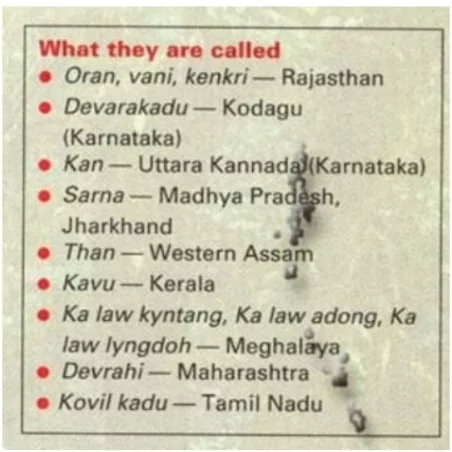Kasampatty Sacred Grove has been officially notified as Tamil Nadu’s second Biodiversity Heritage Site (BHS) under the Biological Diversity Act, 2002.
About Biodiversity Heritage Sites (BHS)
- Biodiversity Heritage Sites (BHS) are ecologically fragile areas that possess rich biodiversity, high endemism, and cultural significance.
- These areas are often conserved by local communities and play a crucial role in maintaining ecological balance.
- Purpose of Declaring BHS: The primary purpose of declaring Biodiversity Heritage Sites is to enhance the quality of life for local communities through the conservation of ecologically and culturally significant sites.
- India’s First Biodiversity Heritage Site: India’s first BHS was Nallur Tamarind Grove in Bengaluru, Karnataka, which was declared in 2007.
Criteria for Declaration of Biodiversity Heritage Sites
- A site is considered for declaration as a Biodiversity Heritage Site if it meets one or more of the following criteria:
- Rich diversity of wild and domesticated species.
- High levels of endemism or the presence of rare species.
- Cultural or sacred significance, such as sacred groves.
- Ecological corridors or habitats that support threatened species.
Legal Framework and Implementation of Biodiversity Heritage Sites
- Biodiversity Heritage Sites are declared under Section 37 of the Biological Diversity Act, 2002.
- The State Biodiversity Boards (SBBs) invite suggestions through Panchayats or Biodiversity Management Committees (BMCs).
- Ecological and cultural studies are conducted in consultation with local communities.
- A Government Gazette notification is issued by the state after public consultation.
- The State Government, in consultation with the Central Government, may frame rules for the management and conservation of these sites.
- The local bodies implement the conservation efforts, while State Biodiversity Boards (SBBs) monitor them.
About Kasampatty Sacred Grove (Veera Kovil Grove)
- Location: The Kasampatty Sacred Grove is located in Kasampatty village, near Alagarmalai Reserve Forest, in Dindigul district, Tamil Nadu.
- Importance: The grove acts as an ecological bridge, supporting pollination and soil fertility in nearby mango plantations.
- It also enhances local climate stability and wildlife connectivity.
- Religious and Cultural Significance: The locals worship the deity ‘Veeranan’ at the Veera Kovil Temple within the grove.
- The grove has been protected following a resolution by the Reddiyapatty Panchayat Council, demonstrating a strong commitment to community-led conservation.
What are Sacred Groves?
- Sacred groves are community-protected forest patches that hold both cultural and ecological significance.
- These groves are conserved through traditional customs and religious beliefs and serve as biodiversity hotspots and water recharge zones.
Legal Protection for Sacred Groves
- Sacred groves are legally protected under ‘Community Reserves’ in the Wildlife (Protection) Amendment Act, 2002.
- Community Reserves are areas designated for conservation with direct participation from local communities to preserve natural resources and wildlife.
Supreme Court Ruling on Sacred Groves
- T.N. Godavarman v. Union of India (1996): This case established that any land with forest characteristics should be considered forest land.
- Expert Committee Report (Rajasthan, 2004): An expert committee in Rajasthan identified sacred groves as forests only if they met specific criteria: a minimum of 5 hectares with at least 200 trees per hectare.
- Supreme Court’s Latest Ruling (2024): The Supreme Court overruled the earlier criteria and directed that all sacred groves be mapped, classified as forests, and declared as community reserves.
- Conflict Between Wildlife Protection Act (WLPA) and Forest Rights Act (FRA): The Forest Rights Act (FRA), 2006, recognizes community forest resources under gram sabhas.
- However, the Supreme Court directive places sacred groves under government control, leading to a legal conflict between community rights and state management.
| Distribution of Sacred Groves in India

- Sacred groves are found across all Indian states, with high concentrations in specific regions:
- Western Ghats & Central Plateau: Kerala, Karnataka, Maharashtra, Chhattisgarh.
- Northeastern States: Meghalaya, Assam, Arunachal Pradesh.
- Tribal Belts: Odisha, Jharkhand, Madhya Pradesh.
- An estimated 100,000 to 150,000 sacred groves exist in India, the highest number in the world.
- Maharashtra leads with nearly 3,000 documented sacred groves.
- The Living Root Bridges (Jingkieng Jri) of Meghalaya, a sacred grove, is part of India’s tentative list for UNESCO World Heritage Sites.
|
Conclusion
By recognizing and protecting these sites, India continues to preserve its rich biodiversity and cultural heritage while supporting local communities in conservation efforts.
![]() 31 Mar 2025
31 Mar 2025

